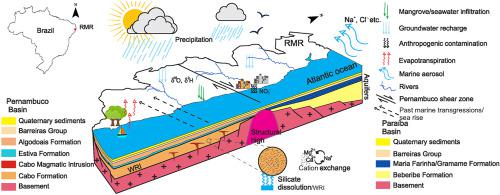Journal of South American Earth Sciences ( IF 1.8 ) Pub Date : 2021-04-06 , DOI: 10.1016/j.jsames.2021.103323 Thyego R. Silva , Teresa E. Leitão , Mariucha M.C. Lima , Tiago N. Martins , Manuel M. Oliveira , Mateus S.C. Albuquerque , Waldir D. Costa

|
The Paraíba and Pernambuco basins are part of the Northeast Brazilian rift system, which contains a series of Cretaceous terrestrial to marine sediments covered by Neogene-Quaternary deposits. Their main aquifers (i.e. Barreiras, Beberibe, Cabo, Quaternary and, Fractured) constitute multi-layered aquifer systems and are the main strategical source of drinking water for the Recife Metropolitan Region. In this research, 323 physical-chemical samples along with 25 isotopic groundwater analyses were used to characterize the main hydrochemical processes controlling groundwater's chemistry and to identify recharge sources. Graphical, ionic ratios and multivariate statistical methods were used to achieve these goals. The correlation matrix was used to evaluate significant associations between 11 geochemical parameters. Principal Component Analysis was employed and a two-factor model is suggested explaining 72.54% of the total variation within the dataset. PC1 is the major contributor to groundwater mineralization and is assigned to ‘natural’ processes (e.g. rock weathering, ion exchange, etc.), and PC2 is related to ‘anthropogenic’ processes (e.g. nitrate contamination). Hierarchical cluster analysis was employed and partitioned the water samples into 28 distinct hydrochemical water clusters (B1–B4, Barreiras; BE1–BE6, Beberibe; C1–C6, Cabo; Q1–Q7, Quaternary; and F1–F5, Fractured). The majority of the cluster samples have Na+–Cl− to Na+–HCO3− water type, including the low salinity groundwater, which in a first approximation could be spatially tied to the recharge zones, and intermediate ones probably related to transition zones. Na+–Cl−to mixed–Cl− water type is typical for high salinity groundwater that more probably results from mixing with infiltrating highly mineralized water. The groundwaters' major ion compositions are primarily controlled by the following interactions: (1) mixing of Pleistocene marine transgression with meteoric Holocene infiltrating water, besides atmospheric deposition; (2) water–rock interactions from silicate rock-forming minerals; (3) ion-exchange reactions; and (4) input from animal/human wastewater. The analyzed groundwater samples showed isotopic signature ranging from −1.98 to +0.36‰ and −2.0 to +7.0‰ for δ18O and δ2H respectively, which is similar to precipitation. These isotopic depleted signatures suggest that most of the deep groundwater was likely recharged from colder epochs and/or from a selection of winter infiltrating precipitation through time.
中文翻译:

伯南布哥累西腓大都会地区多层含水层系统的水文地球化学和同位素组成(巴西东北):使用多元统计分析的综合方法
帕拉伊巴盆地和伯南布哥盆地是巴西东北裂谷系统的一部分,该系统包含一系列白垩纪陆相至新近纪第四纪沉积物覆盖的海洋沉积物。他们的主要含水层(即Barreiras,Beberibe,Cabo,第四纪和断裂的)构成了多层含水层系统,是累西腓大都会地区饮用水的主要战略来源。在这项研究中,使用323个物理化学样品以及25个同位素地下水分析来表征控制地下水化学的主要水化学过程并确定补给源。图形,离子比率和多元统计方法用于实现这些目标。相关矩阵用于评估11个地球化学参数之间的显着关联。采用主成分分析,并建议使用两因素模型来解释数据集中总变异的72.54%。PC1是导致地下水矿化的主要因素,并被分配给“自然”过程(例如岩石风化,离子交换等),而PC2与“人为”过程(例如硝酸盐污染)有关。采用层次聚类分析,并将水样分为28个不同的水化学水聚类(B1 – B 4,巴雷拉斯;贝贝丽贝(Beberibe)BE 1 –BE 6;C 1 -C 6,卡波;Q 1 -Q 7,第四级;和F 1 –F 5,断裂)。多数群集的样本具有的Na + -Cl -对Na + -HCO 3 -水型,包括低盐度地下水,其在第一近似中,可以在空间上绑在补给区,以及中间的人可能与过渡区。娜+ -Cl -为混合-CL -水类型是高盐度地下水的典型特征,很可能是由于与渗透的高矿化水混合而产生的。地下水的主要离子组成主要受以下相互作用控制:(1)更新世的海侵与大气全新世渗透水的混合,以及大气的沉积;(2)硅酸盐成岩矿物在水与岩石之间的相互作用;(3)离子交换反应;(4)来自动物/人类废水的投入。所分析的地下水样品显示同位素特征范围从-1.98到+ 0.36‰和-2.0至+ 7.0‰,δ 18 O和δ 2H分别,这类似于降水。这些同位素枯竭的特征表明,大多数深层地下水很可能是从较冷的时期和/或随着时间的推移冬季入渗降水的选择而补给的。



























 京公网安备 11010802027423号
京公网安备 11010802027423号